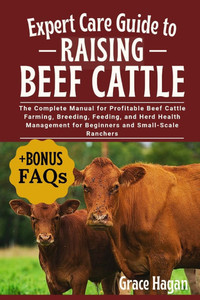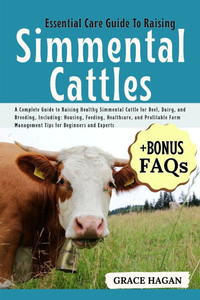
Essential Care Guide to Raising Hereford Cattles: The Complete Beginner's Guide To Raising Hereford Cattle For Beef Production, Breeding, Farm Profit
Independently published
ISBN13:
9798289265357
$17.51
Hereford cattle are one of the most widely recognized and trusted beef cattle breeds globally. Known for their docile temperament, hardiness, and excellent beef quality, they are especially favored by beginners and small-scale farmers. Let's delve deeper into their history, advantages for beginners, and unique characteristics. History and Origin of the BreedThe Hereford breed originated in Herefordshire, England, in the mid-1700s. The region's cool, damp climate and rugged terrain demanded cattle that could thrive under tough conditions. Local farmers began selectively breeding cattle to improve their meat yield, hardiness, and foraging ability.Key milestones in Hereford history: 1742: Benjamin Tomkins is credited as the founder of the modern Hereford breed. Early 1800s: Herefords began to gain recognition across England for their efficient meat production and strong work capability. 1817: The first Herefords were imported into the United States by Henry Clay of Kentucky. 20th Century: Spread to countries like Australia, South Africa, Canada, and South America, becoming a dominant beef breed worldwide. Today, there are two major types: Horned Herefords: The original breed with distinctive white faces and red bodies. Polled Herefords: Developed in the early 1900s in the U.S. to eliminate horns for safety and ease of handling. Why Hereford Cattle Are Ideal for BeginnersHereford cattle are widely regarded as perfect for beginners in livestock farming due to the following benefits: 1. Docile TemperamentNaturally calm and friendly. Easy to handle, reducing the risk of injury to the handler and the animal. Ideal for youth programs like 4-H or FFA. 2. Low MaintenanceRequire less intensive management compared to some other breeds. Adaptable to a wide range of climates, from snowy cold to tropical heat. Resistant to diseases and parasites to some extent. 3. Efficient Feed ConversionExcellent grazers and foragers. High feed-to-weight gain ratio, making them cost-effective to raise. Can thrive on lower-quality pasture if needed. 4. Strong Mothering InstinctsCows calve easily and care well for their young. Low instances of birthing complications. Good milk production ensures healthy calves. 5. Market DemandHigh-quality beef with a good balance of fat and tenderness. Recognized and trusted breed by consumers and meat processors. 6. LongevityCan remain productive (breeding and calving) for up to 12-15 years. Reduces the cost of replacement animals over time. Physical and Behavioral TraitsPhysical Characteristics: Color: Deep reddish-brown body with a distinctive white face, white crest, underbelly, switch (tail end), and legs. Size: Mature cows: 1,200-1,400 lbs (545-635 kg). Mature bulls: 1,800-2,500 lbs (820-1,135 kg). Body Shape: Stocky and muscular, with a blocky frame built for beef production. Coat: Short and smooth in warm climates; can grow thick and curly in colder regions. Polled or Horned: Available in both varieties. Polled (naturally hornless) are more common today.
- | Author: Grace Hagan
- | Publisher: Independently Published
- | Publication Date: Jun 22, 2025
- | Number of Pages: 00140 pages
- | Binding: Paperback or Softback
- | ISBN-10: NA
- | ISBN-13: 9798289265357
- Author:
- Grace Hagan
- Publisher:
- Independently Published
- Publication Date:
- Jun 22, 2025
- Number of pages:
- 00140 pages
- Binding:
- Paperback or Softback
- ISBN-10:
- NA
- ISBN-13:
- 9798289265357





